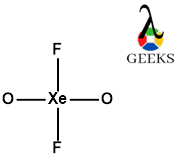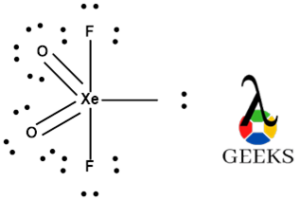In this article, we will discuss about xeo2f2 lewis structure, hybridization, formal charge, and its geometry.
Xenon dioxide difluoride, sometimes known as XeO2F2, is an inorganic molecule with the chemical formula XeO2F2. The partial hydrolysis of Xenon hexafluoride produces it, as shown in the following reaction: XeF6+2H2O —> XeO2F2 + 4HF
- Lewis Structure of XeO2F2
- Formal Charge
- Valence Electrons
- XeO2F2 Molecular Geometry
- Hybridization of XeO2F2
- Octet Rule
The molecular weight of this substance is 201.289 gm.
One xenon atom, two oxygen atoms, and two fluorine atoms make up XeO2F2 (xenon dioxydifluoride). Two single bonds and two double bonds surround the xenon atom in the Lewis structure of XeO2F2, which is surrounded by two fluorine atoms and two oxygen atoms. There are three lone pairs in each fluorine atom, two lone pairs in each oxygen atom, and one lone pair in each xenon atom.
1. Lewis Structure of XeO2F2:
The Lewis structure of an atom is a simplified depiction of the nucleus and valence electrons in its atomic structure. It depicts the electron configuration in an atom.
Electrons are depicted by dots, while the nucleus is represented by the atomic symbol of the atom. A line is used to depict the link between two atoms.
XeO2F2 has the following Lewis structure:

It can be seen from the Lewis structure of XeO2F2 that all of the atoms have reached their octet.
As a noble gas, xenon already has eight valence electrons. In addition, by achieving octet, both fluorine and oxygen atoms that were missing one and two electrons, respectively, have become stable.
However, you might wonder why, since Xenon already had eight electrons, it formed connections with other atoms.
You are correct; most atoms are incapable of doing so. Xenon and other noble gases, on the other hand, are exceptions because they contain empty d-orbitals to accept the additional electrons.
Due to the availability of unoccupied 5d orbitals, xenon may extend its octet and accommodate more than eight electrons in its valence shell.
The Lewis Structure of XeO2F2 can be drawn as follows:
Step by step, we’ll design the Lewis structure of XeO2F2
Step 1: First, we’ll figure out how many valence electrons each of the individual atoms in a single molecule of XeO2F2 has.
Number of valence electrons = 8 for Xenon, a group 18 element.
Number of valence electrons = 6 for Oxygen, a group 16 element.
As a result, the total number of valence e– = 12 for two oxygen atoms.
Similarly, for a group 17 atom of fluorine, the number of valence electrons is 7.
As a result, for two fluorine atoms, the total number of valence electrons is 14.
The total number of valence electrons in the system is 34.
Step 2: We’ll now pick a centre atom for this molecule. For this aim, the least electronegative and most stable atom is usually chosen.
The most stable atom, Xenon, is chosen as the core atom in this example.
Step 3: We’ll then use a single bond to connect all of the participating atoms to the core atom.
This is done to see if any of the involved atoms require extra electrons. If this is the case, more plans are created to finish the octet.

Step 4: The octet for Xenon and fluorine atoms is complete, as seen in the diagram above.
However, each oxygen atom still requires an additional electron, which may be delivered by forming a double bond between Xenon and oxygen atoms.
Step 5: After this stage, all of the participating atoms’ octets are complete, leaving the centre atom with four bond pairs and one lone pair.
As a result, the lewis structure of XeO2F2 is as follows:

2. Formal Charge:
The formal charge of a molecule is used to determine how stable its Lewis structure is. Although it is a hypothetical idea, it aids us in determining whether our derived structure is accurate.
The formula is as follows:
Formal Charge (FC) = Number of valence e– in an atom – Number of nonbonding e–– 1/2 (Number of bonding e–)
A molecule’s formal charge of zero demonstrates its stability.
We’ll now compute the formal charge of each atom in the XeO2F2 molecule.
For the atom of Xenon
The number of valence electrons is equal to eight.
The number of non-bonding electrons is equal to two.
The number of bonding electrons is equal to 12.
As a result, formal charge equals 8 – 2 – ½(12) = 0.
For Fluorine atom.
The number of valence electrons in a molecule is 7.
The number of non-bonding electrons is equal to six.
The number of bonding electrons is equal to two.
As a result, formal charge equals 7 – 6 – ½(2) = 0.
For Oxygen atom,
The number of valence electrons in an oxygen atom is 6.
The number of non-bonding electrons is equal to four.
The number of bonding electrons is equal to four.
As a result, formal charge equals 8 – 4 – ½(4) = 0.
Because each atomic atom’s formal charge is zero. As a result, the XeO2F2 molecule’s total formal charge becomes zero.
As a result, the Lewis structure for the XeO2F2 molecule shown above is accurate.
3. Valence Electrons:
The electrons in an atom circle around the nucleus, which is the core of the atom. Each electron contains a negative charge and is related with a precise amount of energy.
As the electron goes away from the nucleus, the amount of energy it has rises. As a result, the electrons furthest from the nucleus in an atom have the highest energy and are referred to as valence electrons.
The valence electrons, which also participate in chemical bonding, are housed in the valence shell, which is the outermost shell.
4. XeO2F2 Molecular Geometry:
The postulates of Valence Shell Electron Pair (VSEPR) Theory are used to forecast a compound’s molecular geometry.
According to this hypothesis, the geometry of a molecule is determined by the number of bond pairs and lone pairs of electrons present on the molecule’s core atom.
The basic concept is that all electrons are negatively charged, and because similar charges repel each other, electrons repel each other as well. The VSEPR hypothesis uses the amount of repulsion to determine the shape of a molecule.
According to the VSEPR hypothesis, the degree of repulsion differs between bonding and non-bonding electron pairs. The repulsive force between nonbonding electrons is greatest because they are free to move.
Furthermore, because the bonding electrons are already linked to two atoms, their freedom of movement is limited, reducing the repulsion force between them.
As a result, any molecule has two sorts of geometry. The first is electron geometry, which is anticipated based on the bonding atoms, and the second is molecular geometry, which takes into account the function of lone pairs of electrons in defining a molecule’s shape.
We can calculate the number of bond pairs and lone pairs of electrons present on the central atom of a molecule using the VSEPR theory to predict both the electron geometry and the molecular geometry of that molecule.
We already know that the core element, Xenon, contains four bond pairs of electrons and one lone pair of electrons in the case of XeO2F2.
We can now determine the geometry of XeO2F2 using the chart below, which is based on the VSEPR theory’s postulates.
As a result, the XeO2F2 molecule’s electron geometry is trigonal bipyramidal, but its molecular geometry is a see-saw. Furthermore, the bond angles between the various atoms are 91o, 105o, and 174o, respectively.
5. Hybridization of XeO2F2:
Knowing the amount of valence electrons and using the fundamental hybridization formula, we can readily estimate the hybridization of XeO2F2. Number of electrons = ½ [V+N-C+A].
The number of valence electrons in the centre atom is denoted by V. (xenon).
The number of monovalent (fluorine) atoms linked to the centre atom will be N. The cation charge will be C, while the anion charge will be A.
Below, we’ll take a closer look at the procedure.
| Name of the Molecule | Xenon Dioxide Difluoride |
| Molecular Formula | XeO2F2 |
| Hybridization Type | sp3d |
| Bond Angle | 91o 105o and 174o |
| Geometry | Trigonal Bipyramidal or See Saw |
The core atom in Xenon Dioxide Difluoride will be xenon, which will contain 8 valence electrons. The monovalent surrounding atom will be fluorine, while the divalent surrounding atom will be oxygen. We’ll remove Xenon’s eight valence electrons and replace them with two monovalent fluorine atoms. At the end, the total will be split by two.
If we look at the numbers, we can see that the number of electrons is ½ [8+2-0+0] = 5
As a result, the ultimate value is 5, indicating sp3d hybridization. There will be 5 sp3d hybrid orbitals in Xenon Dioxide Difluoride. Around the centre atom, there are 5 electron pairs, with 4 bond pairs and 1 lone pair.
6. Octet Rule:
As previously stated, atoms use their valence electrons to establish chemical bonds. The quantity and kind of bonds established by an atom, on the other hand, are determined by the electrons present in the outermost shell.
In order to become stable, every atom seeks to attain the electrical configuration of its neighbouring noble gas.
Because, with the exception of helium, all noble gases have eight electrons in their outermost shell, atoms of other elements aim to get eight electrons in their valence shell. The octet rule is the name for this rule.
This notion was proposed by Walther Kossel and Gilbert N. Lewis, and it serves as the foundation for all other atom-related concepts such as hybridization, molecular geometry, and so on.
Also Read:
- Beh2 lewis structure
- Caoh2 lewis structure
- Seo3 lewis structure
- F2 lewis structure
- H2co lewis structure
- Brf2 lewis structure
- Alh4 lewis structure
- Ccl3f lewis structure
- Ibr4 lewis structure
- Clf5 lewis structure
Hi….I am D N Madhusudan, I have completed my master’s in General Chemistry from the University of Mysore. Apart from this, I like to read and listen to Music.
Let’s connect through LinkedIn: